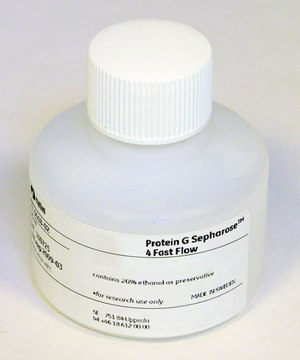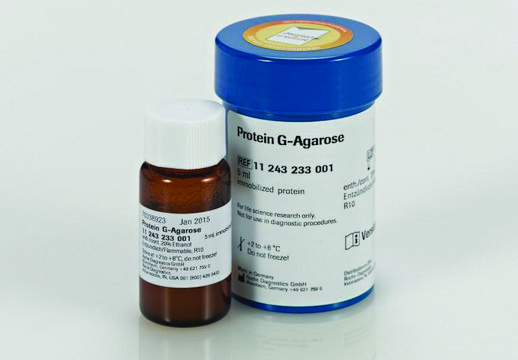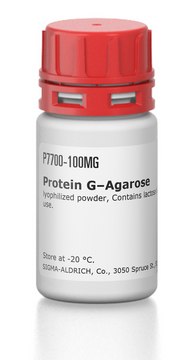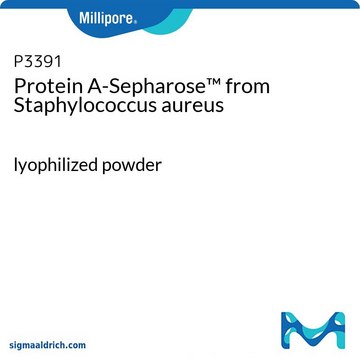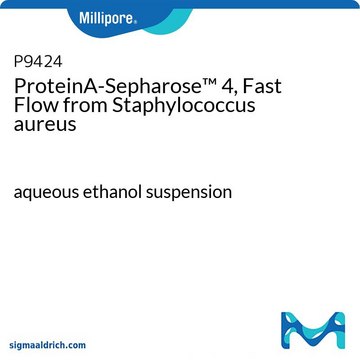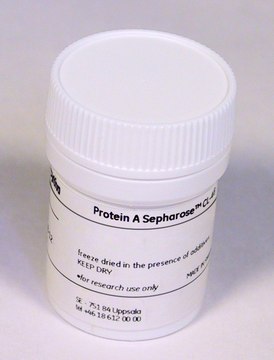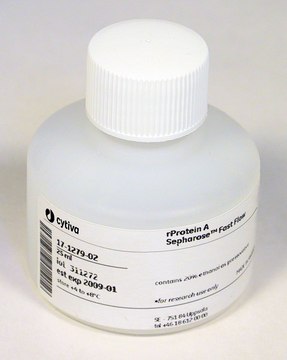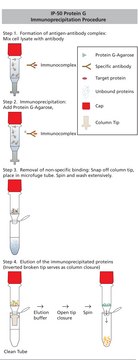推荐产品
ligand
recombinant protein G lacking albumin-binding region
包装
pack of 5 mL
制造商/商品名称
Cytiva 17-0618-01
储存条件
(20% Ehtanol)
基质
4% cross-linked agarose
平均直径
90 μm (d50v)
cleaning in place
2-10
工作范围
3-9
适用性
suitable for bioprocess medium
储存温度
2-8°C
一般描述
Protein G Sepharose™ 4 Fast Flow has recombinant protein G immobilized by the cyanogen bromide (CNBr) method to Sepharose™ 4 Fast Flow. Protein G exhibit binding specificities that complement Protein A media and binds to the Fc region of IgG from a variety of mammalian species. Protein G Sepharose™ 4 Fast Flow may be used to isolate and purify classes, subclasses and fragments of immunoglobulins from any biological fluid or cell culture medium.
As member of the BioProcess media range, Protein G Sepharose™ 4 Fast Flow meets industrial demands with security of supply and comprehensive technical and regulatory support.
特点和优势
- Binding specificities that complement Protein A media.
- Binds a broad range of IgG species and subclasses.
- Multi-point attachment minimizes ligand leakage.
- Used in a range of research applications.
储存及稳定性
分析说明
法律信息
相关产品
警示用语:
Warning
危险声明
储存分类代码
3 - Flammable liquids
法规信息
商品
This page shows a comparison of the relative binding strengths of protein G and protein A to different immunoglobulins.
Purify monoclonal or polyclonal IgG from serum, cell culture supernatant or ascitic fluid using the HiTrap Protein G HP from Cytiva, an affinity-exclusion chromatography product containing Sepharose-immobilized Protein G.
This page describes immunoprecipitation (immunoaffinity or pull-down techniques).
This page describes efficient column packing and preparation for affinity chromatography of antibodies.
实验方案
This page provides information about different pull-down assays for the further isolation of multiprotein complexes to identify their components with products from Cytiva.
This page shows how to separate IgG antibodies by affinity chromatography using Protein G Sepharose 4 Fast Flow from Cytiva.
相关内容
Investigate in vitro protein-protein interactions with pull-down assays, utilizing affinity, GST pull-down, TAP, and co-immunoprecipitation methods.
利用亲和力、GST pull-down、TAP 和共免疫沉淀方法,通过Pull-Down研究体外蛋白质互作。
我们的科学家团队拥有各种研究领域经验,包括生命科学、材料科学、化学合成、色谱、分析及许多其他领域.
联系技术服务部门
